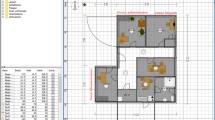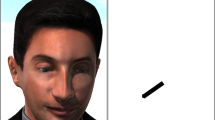Abstract
We report essential tips for collaboration success obtained through the task of the “Marshmallow Challenge.” This involves examining the relationships among task achievement, performance satisfaction, and verbal/non-verbal behaviors throughout the task. We record and analyze the speech and gaze of participants with a video camera. The height of the marshmallow tower is measured as the metric of task achievement. The performance satisfaction felt by participants is obtained with a post-task questionnaire. We use correlation analysis between task achievement/performance satisfaction and verbal/nonverbal behaviors at three stages of the task: the early, middle and final phases. The results suggest that number of agreement utterances in the early phase contributes to increased height of the marshmallow tower. The distribution of the frequency of eye contact in the early phase seem to affect the performance satisfaction of the participants.
You have full access to this open access chapter, Download conference paper PDF
Similar content being viewed by others
Keywords
- Multi-party collaboration
- Task achievement
- Performance satisfaction
- Verbal and nonverbal behaviors
- Marshmallow Challenge
1 Introduction
In our everyday life, we have opportunities to interact with unfamiliar people, for example through exercise activities at university or group work in tasks like job searching. What components make us feel successful in group work? How do verbal and nonverbal behaviors contribute to the success of group work?
There are many kinds of exercises and activities aimed at ice breaking among people gathered for teamwork [2, 5, etc.]. The “Tower Building Challenge” is one of the most famous ice-breaking exercises. The purpose of the task is to build the tallest free-standing tower among several groups by using prepared materials, e.g., newspapers, photocopy paper, straws, index cards and so on.
The “Marshmallow Challenge” task is a particular form of the Tower Building Challenge. This task was invented as a design exercise by Peter Skillman at TED2006 and was discussed in depth by Tom Wujec at TED2010 [9, 11]. The goal is simple: Groups must build the tallest possible free-standing structure in eighteen minutes using only 20 sticks of pasta, 90 cm of tape, 90 cm of string, and one marshmallow. The marshmallow needs to be placed on top of the constructed tower [4].
An awareness of the actual weight of the marshmallow is regarded as a significant factor in the Marshmallow Challenge. The participants must build a tower with sufficient stability to support the weight of the marshmallow on top. The task can be applied to leadership lessons intended to retain the capabilities of a “beginner’s mind” in innovation [1].
We can find many tips for building the tallest free-standing tower on the web, including those for the Marshmallow Challenge in particular. However, there has been little study of tips for collaboration through verbal and nonverbal behaviors in the tower building challenge.
In this paper, our purpose is to find communication tips for successful collaboration by focusing on the Marshmallow Challenge task based on our previous studies [6, 10]. We measured the degree of task achievement as the height of the marshmallow tower and examined the performance satisfaction of the participants through a post-task questionnaire. Participants’ speech and gaze were recorded with video cameras. We analyzed relationships by using correlation analysis among task achievement, performance satisfaction, and verbal and nonverbal behaviors of participants at intervals of six minutes.
2 Method
2.1 Participants
A total of 21 graduate and undergraduate students (mean age: 19.524 years, SD: 1.468) participated in the experiment. The participants had never met each other before the task. No participant was assigned any particular role in the task. Seven groups (g1 to g7), each consisting of three participants, took part in the Marshmallow Challenge task.
2.2 Procedure
Each group was instructed to sit down and face each other around a table (Fig. 1). As participants in the Marshmallow Challenge, they were required to build a free-standing tower by using 20 sticks of pasta, 90 cm of string, 90 cm of tape, and a single marshmallow within a period of 18 minutes.
The most remarkable characteristic of the Marshmallow Challenge task is the possibility of competitors turning the tables on each other in the end due to the actual vs. perceived weight of a marshmallow, since people normally assume that a marshmallow is an extremely lightweight item.
2.3 Parameters
-
Task achievement: We measured the height of the constructed free-standing tower with one marshmallow on top as the result of task achievement after the task was finished.
-
Performance satisfaction: We asked participants seven questions on their performance satisfaction using a four-point scale with a post-task questionnaire (Table 1).
-
Verbal behavior: We extracted the speech of participants through the task of using the ELAN annotation software (EUDICO Linguistic Annotator [3]). We also labeled each speech segmentation using illocutionary act tags based on [7, 8] (Table 2). Each task was evenly split into thirds, i.e., its early, middle, and final phases.
-
Nonverbal behavior: We extracted the frequency of eye contact between two participants throughout the task by using the ELAN annotation software. As mentioned above, each task was evenly split into thirds: the early, middle, and final phases of the task.
3 Results
Figure 2 shows results for the height of the marshmallow tower as a task achievement, while Fig. 3 shows the results for performance satisfaction by using the four-point scale post-task questionnaire after the marshmallow challenge task was finished.
Figures 4 and 5 show the results of analyzing verbal behaviors, utterance duration, and the ratio of each illocutionary act tag to each utterance in the early, middle, and final phases.
Furthermore, the results of nonverbal behavior were analyzed relative to the frequency of eye contact between two participants in the early, middle, and final phases (Fig. 6).
There was a moderate positive correlations between task achievement and performance satisfaction (r = .643). Table 3 shows the results of the correlation analysis between task achievement/performance satisfaction and verbal/nonverbal behaviors. There were strong positive correlations between task achievement and number of all utterances in the middle phase (r = .769) as well as number of agreement utterances in both the early and the middle phase (r = .782, r = .724). There was a strong positive correlation between performance satisfaction and number of proposal utterances in the final phase (r = .889), although there were strong negative correlations with number of the question utterances (r = −.767) or the distribution of the frequency of eye contact (r = −.891) in the early phase.
These results suggest that the more agreement behaviors the participants expressed at the beginning of the task or the more speech used in the middle of the task, the higher a marshmallow tower they built. They also suggest that the more proposal behavior used in the final phase as well as the less question behavior or the less frequent eye contact expressed in the early phase, the higher the satisfaction participants felt.
We applied stepwise multiple regression to detect the interactive roles of leader, active follower, and passive follower. We used 13 sets of verbal and nonverbal behavior data as independent variables (see Table 3) and the results of task achievement (i.e. height of marshmallow tower) and performance satisfaction with the building process as dependent variables.
The regression equations for the interactive roles are as follows:
Equation (1) shows that number of both agreement and proposal utterances in the early phase from 14 sets of behavioral data contribute to the task achievement, that is, maximizing the height of the marshmallow tower.
The Eq. (2) shows that the distribution of eye contact in the early phase and the duration of request utterances in the middle phase from the 14 sets of behavioral data contribute to performance satisfaction with the building process.
We obtained the above regression equation models for detecting the task achievement (adjusted \(R^{2}\,=\,0.827\), p < 0.01) and the performance satisfaction (adjusted \(R^{2}\,=\,0.916\), p < 0.01). The adjusted \(R^{2}\) value shows the percentage of overall contribution of the above selected variables in the regression equations for each interactive role.
In comparing the results of correlation coefficients in Table 3 with regression equations (1) to (2), we find behavioral data with correlation coefficients of 0.2 or more are mostly selected. On the other hand, number of answer utterances or number of statement utterances is not selected as a parameter for higher contribution, even though it has a moderate correlation coefficient. We should examine the adequacy of the model for application to other groups under similar experimental conditions.
4 Conclusion
In this study, we examined the relationship between task achievement/performance satisfaction and verbal/nonverbal behaviors of participants through the Marshmallow Challenge task. As a result, verbal/nonverbal behaviors having some effect on task achievement do not necessarily have a corresponding effect on performance satisfaction, although there was a positive correlation between task achievement and performance satisfaction. In other words, the construction of a higher marshmallow tower is not always directly linked to the satisfaction participants felt with their performance in the task.
As essential tips for successful collaboration, these results also suggest that the more active discussions the participants have, the higher the marshmallow tower they will build; furthermore, the results show that the lower the distribution of eye contact they express, the higher satisfaction with the task they will have.
References
Anthony, S.: Innovation leadership lessons from the marshmallow challenge, Harvard Business Review Online, 09 December 2014. https://hbr.org/2014/12/innovation-leadership-lessons-from-the-marshmallow-challenge
Bordessa, K.: Team Challenges: 170+ Group Activities to Build Cooperation, Communication, and Creativity. Chicago Review Press, Chicago (2005)
Marshmallow challenge. http://www.marshmallowchallenge.com
Miller, B.C.: Quick team-building activities for busy managers: 50 exercises that get results in just 15 minutes. In: AMACOM (2003)
Sakata, M., Miyamoto, K.: Process in establishing communication in collaborative creation. In: Salvendy, G., Smith, M.J. (eds.) HCII 2011, Part II. LNCS, vol. 6772, pp. 315–324. Springer, Heidelberg (2011)
Searle, J.R.: Speech Acts: An Essay in the Philosophy of Language. Cambridge University Press, Cambridge (1969)
Schegloff, E.A., Sacks, H.: Opening up closings. Semiotica, VIII 4, 289–327 (1973)
Skillman, P.: Marshmallow design challenge. In: TED2006. http://peterskillman.tumblr.com/post/74717155833/my-2006-talk-at-ted-in-monterey-3-minutes-on-the
Suzuki, N., Umata, I., Kamiya, T., Ito, S., Iwasawa, S., Inoue, N., Toriyama, T., Kogure, K.: Nonverbal behaviors in cooperative work: a case study of successful and unsuccessful team. In: Proceedings of CogSci2007, pp. 1527–1532 (2007)
Wujec, T.: Build a tower, build a team. In: TED2010. https://www.ted.com/talks/tom_wujec_build_a_tower
Acknowledgments
The contents of this study are based on the fourth author’s graduation thesis. We thank the 21 Doshisha University students who volunteered as subjects for their participation in the experiment.
Author information
Authors and Affiliations
Corresponding author
Editor information
Editors and Affiliations
Rights and permissions
Copyright information
© 2016 Springer International Publishing Switzerland
About this paper
Cite this paper
Suzuki, N., Shoda, H., Sakata, M., Inada, K. (2016). Essential Tips for Successful Collaboration – A Case Study of the “Marshmallow Challenge”. In: Yamamoto, S. (eds) Human Interface and the Management of Information: Applications and Services. HIMI 2016. Lecture Notes in Computer Science(), vol 9735. Springer, Cham. https://doi.org/10.1007/978-3-319-40397-7_9
Download citation
DOI: https://doi.org/10.1007/978-3-319-40397-7_9
Published:
Publisher Name: Springer, Cham
Print ISBN: 978-3-319-40396-0
Online ISBN: 978-3-319-40397-7
eBook Packages: Computer ScienceComputer Science (R0)










